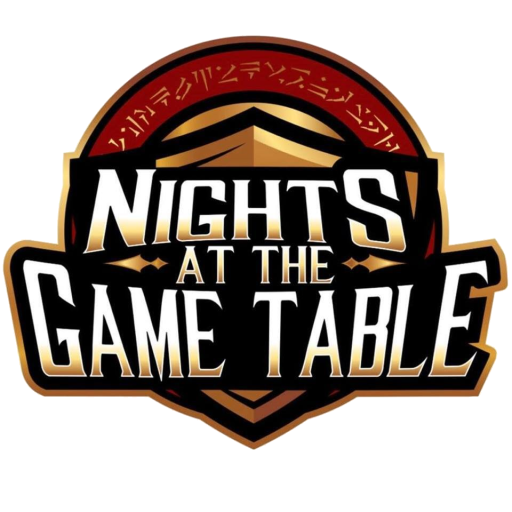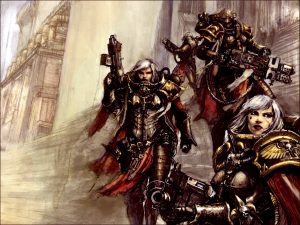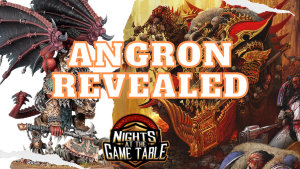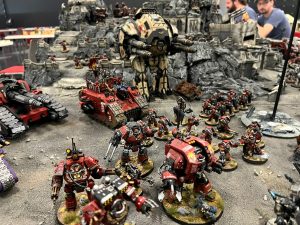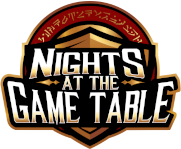Last week we continued our current mini-series, wherein we are looking at playing into our opponents’ weaknesses based on their preferred playstyle. To begin, if you haven’t already, read back to the first article Mind Games article, where we broke down the four play-styles and some of their characteristics.
In this series, we are looking at some on the board strategies to counter various play-styles. This week we’re going to look at the Reactive-Loose Changeling, how to identify them, counter their strengths, and exploit their weaknesses.

Identifying a Changeling:
As we covered previously, a Changeling is a player who favors an reactive-loose style. The elements of a play-style can be sometimes correlated to a person’s personality outside the game, so we can look for some indicators before the models even hit the table that our opponent may lean toward the Changeling play-style.
Identifying our opponent’s tendencies early is helpful not only because it gives us more time to implement our counter stratagems, but it also can help us identify early on when someone may be trying to play counter to their natural play-style and may be more prone to going “on tilt,” playing their aggressive-tight list loosely and reactively when put under pressure.
We also want to assess the play-style that best fits our opponent’s list and if there seems to be a discrepancy between that and their natural play-style, we may be able to gain an advantage by pushing the scenario on the table to skew further away from either their own natural play-style or the most efficient play-style for the list. That is, a Changeling who is running a more Tank-commander-style list may begin holding back and waiting for their opponent to take the first move, rather than strike decisively.
Let us start our identification of a Changeling by looking at some potential personality traits:
- Passive, quiet personality: this player is unlikely to lead a conversation and instead allow someone else to choose topics. They’re also likely to defer to their opponent when walking through pregame-setup, rolls, and more.
- Disorganized: this player is may be disorganized in their pregame setup; their models may not be out of their case, or scattered haphazardly on a carrying tray; they may have scattered their other resources like dice, mission packs, lists, and tape measures across the table, their bags, and carrying tray.
Basically, we’re looking for someone who displays elements of a loose approach by demonstrating a lack of organization, combined with elements of a reactive, passive personality by allowing others to lead conversations and early setup. Obviously, these traits aren’t exclusive or required for someone to lean toward a Changeling playstyle, simply indicators.
When identifying an opponent’s playstyle and approach, it’s important to be regularly reevaluating and reassessing. A wily opponent can be aware of these very same categorizations and actively misrepresent themselves in order to give their opponents the wrong read.
Countering Changeling Plays:
The Changeling play-style is built on a desire to react to their opponent and allow the action to come to them, flowing toward valuable locations and away from threats. It is a fluid play-style and wants to be countering opponents moves with simple counter-attacks.
On the table, we can implement a few strategies to counter or exploit this playstyle’s passiveness and looseness through careful placement or play around objectives, setting traps, and being overly aggressive or overly defensive.
As we all know, objective placement or positioning around objectives is crucial to winning the game. Knowing a Changeling’s tendency toward reactiveness, we can use the positioning of objectives or our positioning around objectives to force action and use it against them to win the mission. However, as a playstyle that can often favor horde, board-control lists, they can often have the body-count and redundancy to be near most objectives.

If our opposing Changeling list features predominantly short-ranged and combat threats, spreading objectives into corners and edges of the board can allow us to spread our opponent’s more numerous forces thin, out of position to support each other. Even in preset objective missions, we can usually still direct their reactions away from the majority of objectives by presenting overwhelming threat to areas near clustered objectives and apparent weakness near more isolated objectives.
If our opponent has a list more focused on ranged threats, this task is a little more difficult, but essentially the same; we can try to use terrain to position our high value targets in places where our opponent must place their own shooting units away from objectives in order to draw line of sight.
If objectives are placed after sides are determined, we can look to put objectives opposite of where the opponent wants to be. That is, if their offensive threats are primarily combat based, placing objectives in corners of their backfield can force a defensive posture. On the other hand, if their offense is more based on shooting, forcing them to come across the board or into positions with poor firing lanes will force a choice between game objectives and offense.
Another way of countering a Changeling and their loose, reactive plays is to set traps. For example, we can position weaker elements to appear unsupported to lure the opponent into taking that area, but then then position our forces to either collapse on that spot in our next turn, or to move to exploit the places our opponent will have to vacate or weaken in order to pounce on the lure.

We can also counter a Changeling by either overwhelming aggression, or extreme passiveness. A Changeling player wants the action to come to them to some degree, and then react on their opponent’s choices to take advantage of areas of weakness, moving away from areas of strength.
The first of these options requires us to present overwhelming strength, with no safer or weak areas for our opponent to flow toward. A Changeling opponent will often try to gum up forward threats to slow them down, so employing aggression with units that cannot be slowed or tied up is important for our aggression to overwhelm our opponent. This approach requires a fairly aggressive list that can be bunched to mutually support its elements, while also having the speed and threat range to pounce on any portions of the enemy army that attempt to escape.
On the other hand, as the opposite of going on an all out offensive, we can put our opponent off by being extremely passive ourselves and forcing them to take the first move. This works better if our Changeling opponent does not have a list that can completely swamp the board but is instead looking to counter aggression with mostly short ranged threats and few long range threats we can simply endure. Such a setup, thanks to a combination of lists interaction and terrain, can allow us to wait-out our opponent before jumping upfield to win the positional game in the late turns when their closer-ranged elements will not have enough time to reclaim control.
For some opponents, waiting them out can force them to move out and take an aggressive stance, which is more likely to be poorly directed or positioned if their game-plan primarily focuses on countering an opponent who moves forward first. The caveat to playing passively like this is that, against a board control list with a lot of bodies, purely hanging back can simply put us into a tighter corner. As such, we should only opt for this approach if we have the tools to out-range and clear out large chunks of an opposing board control force.
So there we have some high-level tactics to employ to counter a loosely reactive Changeling opponent. The earlier we can get a read on this being their playstyle, the sooner we can implement these strategies to take advantage of their tendencies and exploit their weaknesses. Next week, in the final installment of this mini-series, we will look at how to approach and gain advantage over an opponent with a tighter reactive playstyle, the Archon. Thanks for reading, and let us know what you think in the comments below.
